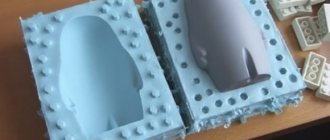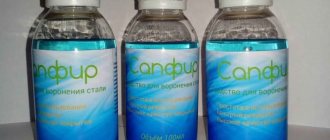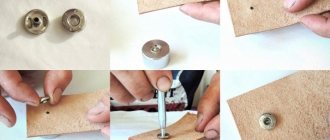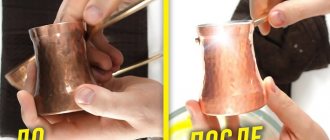Rubber is considered one of the most common materials today. Over time, the basic characteristics may decrease significantly. A fairly common question is how to soften rubber. This procedure can be performed independently at home; it is important to follow all recommendations.
Do-it-yourself tire restoration
All materials lose their performance properties over time. You can often encounter a situation where the rubber becomes too hard and loses its elasticity. If desired, you can restore the basic properties of the material; it does not have to be thrown away. You can soften rubber using a variety of methods. Among the features of this issue, we note the following points:
- Rubber cuffs and seals of some devices lose their basic properties over time. In this case, you can buy new consumables, since their cost is relatively low.
- Some elements are difficult to find on sale due to their unusual shape and properties. In this case, softening can be carried out using various common technologies.
There are quite a large number of different ways to soften rubber, the most common is to use kerosene.
Advice website
Do-it-yourself tire restoration
I think I won’t reveal a big secret by saying that everything in the world deteriorates over time. Everything loses its original properties.
For example, rubber, over time it becomes stiff and loses its elasticity. But this is not a reason to thoughtlessly throw it away.
Everything can be fixed; restoring the elasticity of the rubber will not be difficult.
First of all, what is this for? For example, a rubber gasket has become stiff, so you can buy it in a store.
Or the rubber seals or cuffs have lost their softness, you can also buy them. The era of general shortages is long gone.
But it turns out that this is not entirely true. In small towns, not everything can be purchased, and I’m not even talking about villages.
And besides this, it can be difficult to buy tires of the desired shape due to the fact that there are many rare, almost unclaimed products that are sometimes difficult to buy in a store.
So how does rubber restoration work? And kerosene will help us in this matter.
For small products, for example, let's take rubber cuffs (sealing), rubber gaskets, various rubber seals, etc. and prepare them a kerosene bath.
Pour kerosene into a small container and place the objects to be restored there for a couple of hours.
If the rubber is large, then first you need to carefully roll it up and place it in kerosene.
It would not be amiss to say that reclaimed rubber will regain its former softness and can be reused.
But still, the new is better than the old.
If sooner or later you come across a new rubber cuff or rubber gasket, then it would be right to buy new products and replace the old ones.
What is needed to restore the elasticity of rubber?
Rubber is considered one of the most elastic materials. It is for this reason that it is used in the manufacture of various seals. After the load stops acting on the seal, it is able to return to its dimensions. This moment determines the spread of the question of how to restore the elasticity of rubber. Over time, this property is also lost. If the surface wears too much, cracks appear, due to which the insulating qualities are significantly reduced.
You can soften rubber at home using common substances. The most commonly used substances are:
- Kerosene can easily restore the elasticity index. This substance is ideal for processing small products; it can be softened by soaking them.
- Ammonia can be used to soften the structure. To do this, it is enough to create a small bath in which the product is lowered for several hours.
When soaking rubber in a restoration liquid, it is worth considering that the material can significantly increase in size. To remove the substance from the surface, the product is thoroughly washed with soap and water.
In some cases, you can use hot water to soften the rubber. This method is used to restore the insulation of the refrigerator doorway. The achieved effect can be enhanced by wetting the surface with silicone.
Seals made from the material in question are also used in the production of windows. To improve the insulating qualities of the rubber bands, they are wiped with silicone and glycerin from time to time. Such substances can be purchased without any problems.
Ammonia
The scope of application of ammonia is wide. Softening rubber is one way to use this drug. Many experts explain in detail how to soften rubber using this method. You can make the product softer by following this plan:
- Choose a container of the appropriate size.
- Before softening the rubber, you need to dilute ammonia in the required amount of water (proportions 1:7).
- Soak the product in this solution for a maximum of an hour (in no case should you keep the rubber in ammonia for longer than the specified time; if after 30 minutes it was noticed that the material does not become more elastic, then you should try another method).
- After restoring the desired level of softness, remove the rubber from the bath and rinse with clean running water.
Refurbished products should only be dried at room temperature. Direct sunlight and high temperatures can negatively affect the condition of the material.
Medical alcohol has similar properties, but additional glycerin is required. If the rubber has hardened, logic will tell you how to soften it. The damaged product should be soaked in medical alcohol for several hours, then it should be removed and washed with warm running water and soap. After the surface has dried, you need to rub in the glycerin using a cloth or sponge. There should be a little glycerin, the excess must be removed. Instead, you can use car oil (in this case, you can use the product only after 30 minutes).
How to make rubber elastic?
Experts recommend considering each specific case, which can significantly increase the efficiency of the work being carried out. You can soften the rubber as follows:
- Hardness increases if the rubber is kept dry for a long time. Elasticity is restored by wetting the surface with oil. Softening is recommended to be carried out periodically to achieve the desired result.
- Car wipers can be lubricated with silicone grease, which softens the surface. Of course, it is possible to restore an old structure only if there are no mechanical defects.
In addition, you can find special compounds on sale that can soften the structure after application.
Silicone and castor oil
These home remedies to restore elasticity have some disadvantages. One of them is a short-term effect, which is not always convenient. But there are still some advantages:
- availability (silicone can be purchased at any specialized store, and its cost is low);
- does not require prolonged exposure (the product is ready for use within 30 minutes after the start of the procedure);
- there is no need to look for large containers for soaking products (you do not need to do this before softening the rubber with silicone).
These features also apply to castor oil. The substance is able to penetrate the rubber structure, thereby changing its properties. But it is also easy to wash out.
Sources
- https://essen-ware.ru/vannaya/kak-razmyagchit-rezinu.html
- https://molotok34.ru/spravochnik/kak-razmyagchit-rezinovuyu-prokladku.html
- https://profistroy74.ru/masteru/kak-razmyagchit-rezinovuyu-prokladku-v-domashnih-usloviyah.html
- https://peugeot-2008.ru/raznoe/kak-smyagchit-zimnjuju-rezinu.html
- https://gktsg.ru/raznoe/kak-vosstanovit-elastichnost-reziny-v-domashnih-usloviyah.html
- https://armatool.ru/kak-razmagcit-rezinu-v-domasnih-usloviah-esli-ona-zadubela/
- https://moy-instrument.ru/masteru/kak-razmyagchit-rezinovuyu-prokladku-v-domashnih-usloviyah.html
- https://okna-dveri73.ru/poleznaya-informaciya/kak-razmyagchit-rezinu.html
- https://spb-metalloobrabotka.com/kak-razmyagchit-rezinu-v-domashnih-usloviyah/
- https://FB.ru/article/463075/kak-razmyagchit-rezinu-v-domashnih-usloviyah
[collapse]
How to soften rubber at home?
At home, you can soften rubber by using various materials. The most widespread are:
- Ammonia.
- Kerosene.
- Castor oil and silicone.
Restoring rubber at home
High temperatures also cause the rubber to become softer, but wear resistance decreases.
Kerosene
When considering how to soften rubber, many people pay attention to the possibility of using kerosene. Such a substance can restore elasticity.
Features of the application are that the product is soaked in a special bath, after which the surface is thoroughly washed and dried. If the length of the product is large, then it can be rolled up. It is kept in kerosene to soften for several hours, since kerosene does not act immediately.
Ammonia
This substance is widely used and can also make the product softer. The procedure looks like this:
- Select a container of suitable volume.
- Ammonia is diluted in water to obtain the required solution.
- The product is placed in the solution for an hour to soften.
- After this, the softened element is removed and washed with clean water.
Drying is carried out at room temperature. It is worth considering that high and low temperatures always have a negative impact on the condition of the rubber.
Silicone and castor oil
A short-term effect can be achieved by using silicone and castor oil. Among the application features, we note the following points:
- Silicone has only a temporary effect. It can be purchased in specialized stores.
- After lubrication, you need to wait a while. The silicone can be absorbed into the structure, making it more flexible.
After half an hour the rubber will be ready for use. It is worth considering that the achieved effect will be temporary. When considering what can be used to soften such material, you can pay attention to castor oil.
Heating
In some cases, only temporary softening is required, for example, when putting a hose on a pipe. The problem in this case can be solved by temporarily lowering the product into a hot bath. After some time of exposure to high temperature, elasticity increases.
With prolonged use, the rubber may become hard. Problems can only be solved if the product is boiled. The effectiveness of the procedure can be significantly increased by adding salt to the composition. Boiling is carried out until the surface becomes elastic.
If difficulties arise when removing tubes and hoses, then heating is carried out by applying a warm air flow. A construction or regular hair dryer can be used for this. When the high temperature air flow is concentrated in one place, the plasticity increases significantly.
In conclusion, we note that only in the absence of defects can the material be restored. Some recommended methods may reduce some performance characteristics. That is why you need to follow all recommendations.
If you find an error, please select a piece of text and press Ctrl+Enter.
Source stankiexpert.ru
Rubber is used in many household structures: various hoses, seals, adapters, car parts. Over time, products made from this material fail, dry out, lose elasticity, and become inconvenient to use. You shouldn’t buy new elements right away; you can try to soften the rubber at home.
What to do if the toilet is clogged: how to diagnose the clog and remove it
Clogs are the most common plumbing problem. It can be caused by deposits of hard water salts, organic sediments and other debris that gets into the sewer pipe, narrowing its internal opening.
In some cases, a clogged toilet is the result of the actions of apartment owners who dump leftover food, fermented household ingredients and dirty water into it after cleaning the room. How to diagnose a blockage and what to do if the toilet is clogged without involving expensive specialists, let’s try to understand this material.
Features of home sewerage
Sewage is an integral part of the drainage and water supply system. It is designed to remove liquid and solid products of human activity, to purify household water from contaminants and return them for further use or into a reservoir. A sewerage system is necessary for comfortable living in a house or apartment.
Residents of apartment buildings are responsible for the condition of sewer pipes in the apartment, and owners of private properties must independently install local treatment facilities, remove sewage, and maintain pipelines and equipment.
In order to avoid unpleasant problems in the future, you should comply with the requirements of SNiP regulations on water drainage and sewerage. Then the system will work normally, without requiring constant monitoring or adjustment.
The internal sewer networks include:
- plumbing fixtures with water drainage;
- a common riser to which sewer pipes are connected;
- pipe layout that ensures the process of transporting wastewater from the drain hole to the riser.
Requirements for internal networks are specified in SNiP “Internal sewerage”, in GOST and SNiP “Sewerage”. The systems are installed inside the building and ensure the transportation of all wastewater from the place of its formation to the pipe exiting the building.
Basic requirements for internal networks:
- When installing plumbing fixtures on drains, a water seal is required.
- Cast iron or plastic pipes are used for laying networks.
- The diameter of the sewer system outlet from the house is at least 110 mm.
- When laying pipes, a slope of 2 to 2.5% must be maintained.
The internal networks of the sewer system must be equipped with ventilation. The process of ventilating the networks is carried out through common sewer risers - an exhaust part is installed, leading to the roof.
Due to the resulting blockages, normal drainage of wastewater becomes impossible, so it is necessary to immediately resume the full functioning of the sewer system. In order to avoid unpleasant consequences due to a blockage in the pipeline, you need to call specialists or clean the sewer yourself.
How is the sewage system arranged in apartments?
Sewage in modern apartments performs the task of removing human waste. For this purpose, a waste disposal line is installed from each point where waste is generated (toilet, sink and bathtub) to a common sewer riser.
Apartments located on adjacent floors are connected to it. The riser is a large pipe with a diameter of 0.1 m, located in the bathroom.
All sewer systems that are built in apartment buildings and private buildings must strictly comply with construction and sanitary standards.
Previously, only cast iron pipes were used for sewerage installations, but now mostly plastic ones are installed. In a plastic pipeline, the possibility of blockages is less likely, since defects do not appear on the walls, and “overgrowing” of the riser section occurs very rarely.
To make it easier to clean the riser in a high-rise, holes are made on each floor - sewer inspections.
The standard configuration of a plumbing fixture (toilet, washbasin or bathtub) looks quite simple:
- device drain hole;
- siphon (a curved elbow that is connected to the waste disposal line);
- supply pipeline to the riser;
- large pipe or riser.
The blockage can be observed in any area, but it should be borne in mind that the cause of its appearance is man-made. If the plumbing fixture is used for its intended purpose, there should be no problems.
What to do if there are signs of blockage?
Every property owner should know what to do if the toilet is clogged in the bathroom. The first thing you need to do is warn your neighbors living on the floor above and ask them not to temporarily use the toilet, bathtub or washbasin. Then it is recommended to make a chop or kvach, which should be used to plug the drain hole.
Method for making the simplest chop:
- You need to take a wooden block about 0.5 m in length, the cross-section of which is 1 cm smaller than the toilet flush.
- The block should be wrapped in sheet foam rubber (1 cm thick) in several layers.
- You need to put several plastic bags on the “balda”, tying them with twine.
- The “buld” of the chop must be tightly installed in the drain hole.
After this, you can, with the help of your neighbors, find out the cause of the clogged plumbing fixture and determine the location of the clog.
If the water drains slowly from the toilet, and everything is fine with your neighbors, then the blockage occurred before the line entered the sewer pipe. If there is a local blockage, you can call a plumber to your home, or you can try to eliminate the cause of its appearance yourself.
If the water in your toilet rises when the taps are closed and the tank is not drained, then the blockage is located lower down the common riser.
In most cases, unclogging a toilet or cleaning a sewer pipe can be successfully done on your own. Chemical and mechanical methods are used to clean pipes. The methods for removing blockages in an apartment building or in a private house are not fundamentally different.
The main reasons for a clogged toilet
The main task of the home owner is to promptly identify the problem of clogged plumbing and urgently take measures to eliminate it. If water stagnates in the toilet, it is necessary to act promptly, but first you need to determine whether the water is draining in the remaining sewer units (sink, shower, bathtub).
The main reasons for a clogged toilet:
- “overgrowing” of sewer pipes;
- improper operation of plumbing equipment;
- poor choice of model and errors when installing the toilet.
If the water gradually drains from the toilet, and everything is fine with your neighbors, then the blockage is located no further than the outlet of the main line into the sewer pipe. In case of local clogged plumbing, you can call a professional specialist, or you can try to fix the problem yourself.
The main reason for the slow drainage of water is the “overgrowing” of sewer pipes.
If the rules of operation of the sewer system are violated or due to sand, grease, hair and other insoluble substances entering the system, a blockage often occurs. The lumen of the pipe decreases and if the problem is not immediately eliminated, then compaction of the drain occurs, causing “paralysis” of the sewerage system.
As a result of clogged plumbing, the water stops partially or completely leaving, and an unpleasant odor appears in the bathroom. In order to eliminate this problem, it is necessary to clean the sewer.
Errors in the installation of plumbing equipment usually occur when choosing the wrong toilet model, which is not structurally compatible with the place where it is installed. The presence of this problem is indicated by an incorrect slope of the water drain line from the plumbing fixture to the riser. In rare cases, the design of the toilet contributes to the formation of blockages.
A clogged drain in an apartment building is a “public” problem, since it can be initiated by you or your neighbors, and collective participation is not excluded.
Clogging of liquid waste along the route within the apartment is your problem, so it is better to eliminate it yourself. Rags, cat litter, diapers, construction waste and other items that fall into the toilet are not considered liquid waste, so these blockages are quite difficult to remove.
We also recommend reading our other article, where we examined in detail the types of sewer blockages. If you are interested in details, follow the link.
Effective ways to clear a clogged toilet
A blockage often forms in the sewer system, as a result of which the water stagnates and it becomes impossible to operate the plumbing equipment. At the same time, an unpleasant odor appears in the bathroom, which cannot be removed.
Before you begin cleaning your sewer pipes, you need to identify the source of the standing water. Usually, a clogged toilet is a result of improper use of the drain hole.
There are several effective ways to get rid of a clogged toilet on your own.
Method number 1 - cleaning pipes with vinegar and soda
If the sewer pipes are clogged in the bathroom, in most cases there is no need to seek help from professional plumbers. First, you can try to clean the sewer system yourself using water, vinegar and soda. This is a simple and effective way to clear sewer pipes from simple blockages.
Before you begin removing the blockage, you need to heat a bucket of water to boiling temperature, after which you need to pour the water into the problem toilet, creating a strong pressure. To do this, install the bucket in such a way that hot water pours into the toilet as quickly as possible and at a right angle.
If after cleaning the liquid begins to gradually disappear, the procedure must be repeated. These simple steps will help you deal with light blockages.
An equally difficult option for cleaning a clogged toilet is using vinegar and regular soda. The ingredients are poured into the siphon in equal quantities (2-3 spoons). After about 20-30 minutes they can be washed off with hot water. Despite the simplicity of performing the steps described above, removing the blockage yourself requires strict adherence to safety measures.
Recovery methods
Rubber elements, under the influence of external factors, lose their original properties, become less elastic, and harden. Their continued use will not bring the desired effect; seals, for example, will not be able to make the system completely sealed. Purchasing new rubber elements is sometimes difficult due to the lack of products of the required sizes or their inflated cost.
The following substances can soften rubber:
- Kerosene. Allows you to make rubber parts soft, affecting the structure of the material. After processing, the rubber element becomes completely elastic. The recovery technology is as follows:
- fill a small container with kerosene (select the container size depending on the size of the product to be restored);
- place the part in a container with kerosene for 3 hours;
- after the specified time, check the product for softness, if the result is satisfactory: remove the material and rinse with warm running water;
- Dry the material naturally, without using a hair dryer or battery.
- Ammonia alcohol. The process for restoring old material is as follows:
- dilute the specified alcohol with water in a ratio of 1:7;
- place the rubber material in the resulting solution for half an hour;
- after the specified time, remove the part and rinse with warm running water;
- Allow the part to dry completely before using it.
Please note: you cannot keep rubber in a solution of ammonia and water for more than an hour. If the material is not elastic after 30 minutes, use another recovery method.
- Rubbing alcohol followed by glycerin. Technology for “reanimation” of rubber parts:
- fill the container with medical alcohol;
- place the part that requires restoration in alcohol for several hours;
- after the specified time, check the condition of the product, if it is soft enough, remove the element from the solution and wash with warm soapy water;
- rub glycerin into the surface of the part using a sponge (cloth);
- remove any remaining glycerin from the surface of the product.
Instead of glycerin, it is allowed to use automobile oil; it is rubbed into the surface of the product, then the part is left for half an hour before use. During this period, the rubber becomes quite elastic.
- Castor oil and silicone. Let’s make a reservation right away - this method allows you to quickly “reanimate” old rubber, but the restoration effect will not last long; after a few days the product will become hard. For this method, follow the sequence:
- coat the part with silicone;
- wait 10 minutes;
- After the specified time has passed, the part can be used.
Please note: a similar effect is achieved by using castor oil. It is rubbed into the surface of the part, after which it becomes soft and elastic.
We recommend watching a video about softening rubber using ammonia:
Rubber extraction
The process of obtaining rubber is extremely simple. Hevea trees begin to produce resin at the age of 7-8 years: it is then that the first cuts are made in them, from which white thick milky sap oozes. Each tree produces about 200 grams of sap during the day, which is collected in small cups tied to the tree. In the evening, the collected juice is poured into large containers and sent to processing factories. The milky sap is collected daily until the tree is about 30 years old, when it dries up. The plantation is completely cut down and young shoots are planted in its place.
In fact, the juice collected and cleared of branches and insects can already be considered a finished product, since it quickly thickens in air and turns into a dense rubber mass, but to speed up the process, special thickeners are added to it and placed in flat small trays of square or rectangular shape. Then the resulting dough-like adhesive mass is rolled with a press, squeezing out the remaining moisture from it, and dried. Thus, you can get natural rubber almost by hand, giving it the desired shape and evaporating all the moisture.
The last step of the primary treatment is to smoke the resulting rubber sheets in order to get rid of ants and other insects. It is smoking that gives the sheets a brownish-yellow color, which is considered classic for natural rubber.
Latex sleep products (pillows, mattresses) are currently produced from natural rubber.
Has it ever happened that the elastic band around the cards simply broke due to age, your favorite sneakers became hard as a rock, or the vacuum cleaner failed due to the fact that a small gasket, belt or cuff had hardened in it? If the answer is yes, you know that rubber becomes hard over time. Natural rubber loses its properties and hardens under the influence of temperature, oils and even oxygen. Because of this, one way to slow down the hardening of rubber products is to limit exposure to heat, oils and oxygen. At the same time, the correct use of heat and oils can partially restore the softness of rubber products, although it is impossible to completely stop hardening.
Heating is an effective method
There are situations when the rubber element, due to its hardening, is difficult to remove from structural parts. You can achieve the desired result by heating the rubber with a stream of hot air using a hair dryer. When exposed to high temperatures, the material will become softer and can be pulled out of the part.
An element that is too “stiff” is softened by boiling in salted water. The technology is as follows:
- fill the container with salted water;
- let the liquid boil;
- place the rubber element in boiling water for 10 minutes;
- remove the rubber and quickly use it for its intended purpose.
This method is quite effective, but has a short-term effect. Once cooled, the rubber will become hard again.
Several ways to fix the problem: the toilet cistern is leaking through the flush valve
Any malfunction associated with leakage of liquid in the toilet causes discomfort.
A thin stream of water creates constant noise, gradually spoils the toilet cover and increases the owner’s costs for water supply services.
This happens because the drain valve has failed and cannot hold liquid inside the drain tank, allowing it to leak into the bowl.
How does a drain valve work?
The drain valve is a mechanism that keeps a mass of water inside the tank when it is not in use. It also releases liquid into the toilet bowl when flushing.
The drain valve design is based on the action of pressure and traction force.
When the tank is full, the water pressure allows the membrane or bulb covering the flush hole to be held in place, preventing leakage. When a lever or button is pressed, the mechanism is activated, opening the hole and allowing water to flow into the bowl.
Why is water running through the inlet tank, it leaks and does not hold it
The valve will leak if the rubber gasket material to which the locking mechanism is attached has dried out.
If the mechanism does not hold water, the reason may lie in damage to the membrane. If a rubber bulb plays the role of a regulator, it may have lost its elasticity.
Is water constantly flowing in the tank? This is also possible if the float is broken, which should stop supplying water as the container fills.
Attention! The water supply may not stop due to the displacement of the lever that controls the correct position of the drain mechanism inside the container.
How to repair a leaking toilet drain if it's broken
In most cases, it is quite possible to repair a leaking tank yourself.
It is not necessary to seek the help of plumbing experts. First, the plumber turns off the water.
Then you need to empty the container of the liquid in it that is flowing.
Depending on the type of malfunction that occurs, certain actions are taken.
Replacing the gasket for the mechanism
To carry out repairs, you will have to remove the container from its place by unscrewing the fastening screws (in compact models). Next, you need to remove the drain mechanism, remove the old shut-off membrane (rubber gasket), and install a new part of the same diameter in its place. Additionally, you can lubricate the junction of the gasket with the tank with a special sealant.
What to choose for caring for tires – silicone lubricant or tire dye?
Car owners often face the question: what is better to treat tires with silicone grease or rubber ink?
Which option is more effective, cheaper and more convenient to use? The effect of using silicone grease and inks of different quality. It is known that cheap tire ink does not have a serious effect on tires and is only suitable for decorative purposes. Silicone grease seems like a suitable option - it not only improves the appearance of the tires, but also fills microcracks and masks defects. In addition, the effect lasts longer than using cheap ink. So which is best for tires?
Tire dye actually does a worse job of caring for tires than silicone lubricant, but this only applies to cheap glycerin-based products. But for the production of expensive ink, silicone is used and the effect of use differs significantly.
The silicone-based lubricant is waterproof and creates a protective film on the tires that does not allow water and dirt to linger on the surface. This film also protects rubber from exposure to ultraviolet rays and makes its color more saturated due to slight refraction of sunlight. After treatment with such a lubricant, the tires begin to look like new, but this product also has a drawback - the effect is not long-lasting, just get your car in the rain or send it to the car wash, and the silicone lubricant will be completely washed off and you will need to carry out the treatment process again.
Silicone-based ink has a similar effect, but the effect lasts much longer. As an experiment, you can try treating one car wheel with this ink and the other with silicone grease to compare the result. Visually there will be no differences between the wheels, but after several washes or trips, the silicone grease will be almost completely washed off, but the ink will remain.
Comparison of cost and consumption of the product. Another parameter by which these two products can be compared is cost and how economically they can be used. Silicone grease and high-quality ink have different prices, the latter being more expensive. However, this disadvantage is compensated by the long-term effect of the ink and its minimal consumption. To treat the surface of the same wheel, it will require much less than lubricant. In addition, subsequent tire treatments will require a minimal amount of ink, since the product is not washed off the surface even after water or long trips. Silicone grease cannot boast of this property - after contact with water, it is completely washed off, which is why the wheels have to be reprocessed.
Bottom line. What's better? Therefore, the best option for tire care is a quality silicone-based tire ink. Silicone grease has a similar effect but does not last long, but is much better to use than cheap glycerin based inks.
Source
Stage two: update
Not only a person, but also all objects around him age over time. Rubber bands in the refrigerator are no exception. From light, moisture, temperature changes, mechanical stress (slamming the door), the seal gradually collapses.
On average, sealing bands in a refrigerator last 3-5 years. Then they gradually become compressed, and the door no longer closes tightly.
Rubber contains synthetic rubber and polymers that absorb light and heat energy. Chemical processes occurring inside change the seal externally. All rubber becomes dense over time. At the same time, it loses flexibility and breaks easily. Microscopic cracks appear on the surface in which moisture accumulates. This further accelerates the destruction process.
Is it possible to somehow rejuvenate the tires? At the initial stage of aging - yes. There are several proven methods for this.
Method number 1 - using lubricant
Many people know that plastic windows need periodic lubrication. The rubber bands around the sashes are lubricated twice a year. This increases their service life by 2-3 times. So the window seal is not much different from the one in the refrigerator. When lubricated, the rubber remains elastic longer. Lubricant protects it from the negative effects of the environment, and to some extent softens it.
To lubricate the sealing rubber bands of the refrigerator, you can use:
- care product for plastic windows;
- silicone grease;
- machine oil;
- VD-40.
The lubricant is applied to a clean, dry surface. It is best to rub it in thoroughly with your fingers (wearing gloves). You need to process all the folds and leave the sealant for half an hour. Then excess lubricant is removed with a dry cloth.
Method number 2 - using ammonia
If a suitable lubricant is not at hand, you can use ammonia. It acts rougher and is able to change the structure of the rubber for both the better and the worse.
It is important to strictly adhere to the recipe and exposure time:
- We dilute ammonia in warm water in a ratio of 1 to 7.
- We wipe the rubber several times for half an hour.
- Wash off the solution with warm, clean water.
- Dry it.
It is most effective to soak the seal in ammonia solution. But not all refrigerators have it removed. You need to see if the elastic is simply inserted into the groove or is additionally glued.
Method number 3 - using a hair dryer
It is known that when heated, any rubber softens. A household hair dryer will help heat it up quickly. However, heating alone is not enough. After cooling, the seal will become the same as it was.
The hairdryer is held at a distance of 20-30 cm. To increase efficiency, the rubber treated with lubricant is stretched. At the end, the seal is heated again. Without allowing it to cool completely, close the door and press it with your hands for 3-5 minutes. This is necessary so that after cooling it becomes uniform in thickness.
Method number 4 - using boiling water
The most barbaric method, but sometimes it is the only one that helps solve the problem with an elastic band that comes off. Boiling water instantly softens the material. But its destruction may also occur. The fact is that the composition of the seals is very different: natural, synthetic rubber, a mixture of different polymers. Therefore, in each specific case the result is different. If you decide to take a risk, the procedure is carried out as follows:
Option #1. The door is opened. A large basin or tray is placed under it. Boiling water is slowly poured onto the gum on top (it’s most convenient to do this from a kettle). Then quickly, while it has not yet cooled down, stretch the folds with your hands. Close the door tightly. After 3-5 minutes, wipe off the moisture and dry everything thoroughly.
Option #2. The seal is removed from the grooves. Heat 3 liters of water with the addition of a glass of salt (or without). After boiling, pour the boiling water into a plastic bowl. Lower the seal for 10 minutes. Take it out and level it by hand. Set in place.
Steps
How to prevent hardening
Inspect rubber products regularly.
Any rubber object, be it a windshield wiper blade on a car or the elastic waistband of your favorite pajamas, slowly but surely becomes hard. White or colored marks on the rubber may indicate that a chemical reaction is occurring.
Look for signs of damage.
Cracked rubber will remain cracked even if the product is softened. If cracks occur, you can use a rubber patch or simply buy a new item. There are no miracles in this situation.
Keep rubber products clean.
It is quite difficult to protect products from oxygen, temperature fluctuations and light, but you can regularly wash off the coating so that destructive oils do not destroy the rubber object.
Store the rubber product in an airtight container to slow hardening.
If possible, remove air (and oxygen along with it) from the container before packaging.
Store container in a cool, dry and dark place.
The same place where apples and potatoes are usually stored will do.
How to Soften Rubber with Heat
- Select your preferred heat source.
The easiest choice is an oven or hairdryer, but some people prefer to place rubber-soled shoes on the radiator. Make sure the oven is set to a low heat setting and the hair dryer is set to a high heat setting to ensure roughly equal temperatures.Place the item in the oven at low temperature.
In case the oven overheats and the rubber starts to melt, it is better to place the product on a baking sheet or a suitable form (one in which you do not cook food).
Warm up the rubber with a hairdryer.
Shoes with rubber soles should be heated for 7-10 minutes on the highest setting of a hairdryer.
Do not hold the hair dryer at one point and constantly monitor the condition of the rubber to prevent melting and other damage.
- Leave the rubber to cool for 10 minutes.
Then try the product by touch. If you're lucky, the rubber will remain soft and pliable even when it cools down.
In many cases, rubber products are completely irreplaceable. Various seals, belts, hoses and other parts are found in the design of household items and automotive equipment. But with prolonged use or overcooling, they can become hard and unsuitable for further use. How to soften rubber at home? There are substances and methods of influence that help achieve the desired result.
Tire blackening
Tire blackening agent is used to care for the vehicle and give it aesthetics. There is a wide range of similar special products on the shelves of auto chemical stores. Do-it-yourself folk ones can also serve as a good alternative to some of them.
During the operation of a car, wheels are most susceptible to the influence of external factors. The sun, water, salts, chemicals and bumps on the road are the main culprits in the aging of a tire and the loss of its original (store) appearance. Restoration using the rubber blackening method will help restore freshness and former beauty. This can be done using several mixtures, in particular: glycerin, shoe polish, soap, silicone or a specially developed liquid. To figure out the best way to blacken tires, you should weigh all the pros and cons of each treatment.
Do-it-yourself tire blackening procedure
Folk remedies for softening shoes
Many people use castor or linseed oil to soften their shoes. A similar substance is applied to a leather product for several minutes, after which the shoes are polished. Linseed oil is especially useful in this case - it can be applied to the seams, which will make them waterproof.
Often, ordinary boiling water is used to soften shoes. You should simply pour it into your shoes, hold it there for a few seconds and pour it out. Immediately after this, the shoes are put on and worn in until they are completely dry.
You can prepare the ointment at home. To do this, melt the wax in a water bath, then mix it with turpentine and castor oil. This product will give the skin an additional natural shine, make it soft and prevent moisture from penetrating inside.
A fairly reliable way to soften shoes is to use kerosene. To do this, the shoes should be treated with boiling water, after which they are wiped with kerosene and dried thoroughly.
The simplest method for softening shoes is to use Vaseline. This substance is very beneficial for natural leather, so it does not need to be removed after use. Vaseline is thoroughly rubbed into the shoes and left for a couple of hours. After that, it is cleaned with a special cream and polish.
Some people use a vinegar solution to soften their shoes. The essence is diluted to a concentration of no more than 10-12% and rubbed on a leather product. After such an operation, it is left for several minutes, washed and cleaned.
It is worth noting that such methods can only be used for natural leather. Shoes made from artificial materials may lose their attractive appearance or even deteriorate completely.
It is strictly not recommended to use sunflower oil to soften a leather product. This remedy will cause the shoes to become even more rigid and brittle. In principle, shoe repair and maintenance professionals advise that after using any product, wear thick, thick socks under leather shoes and walk like that for the next couple of hours.
This will allow the shoe to mold to the shape of your foot and secure it in place. As a result, this product will no longer rub in any area. It is worth noting that leather shoes require constant care and protection - in this case they will last for a long time.
Frequently asked questions - answers
What can replace silicone molds?
An excellent alternative is glass and ceramics.
What is the electrical conductivity of silicone?
Has very low electrical conductivity.
Which silicone is best for making molds?
The best series are E-Series, Mold Star Series, Equinox Series, Rebound Series.
How to glue silicone products at home?
You can use special glue for elastic products, silicone sealant, or melt the torn edges with fire and connect them.
How to make liquid rubber at home?
The necessary ingredients are borax (1 pack), PVA glue (2 bottles), water (0.5 cups), dye, containers and something for stirring. Combine borax and water in one container, stir until clear. The other contains glue and dye. Mix the contents of both containers and wait until the liquid hardens.
How long does it take for silicone to cure?
The drying period is influenced by many factors - humidity and air temperature, layer thickness. On average, a film is formed in 15 minutes, and the substance hardens in 24 hours. Acid sealant dries in 4-6 hours, neutral sealant dries in 24 hours. Also, the approximate “ready” time is always indicated on the packaging.
A car surrounded by care stands out from the crowd. The car enthusiast washes and polishes the body, polishes the plastic moldings. Tires are often the object of intense cleaning. As you know, these parts lose their original appearance during the first year of operation. This is due to weather conditions and dust scourge. The result is that the car shines, and the tires give off a characteristic gray tint, which only repels the eye.











